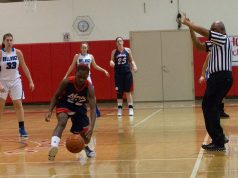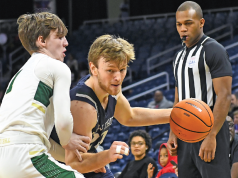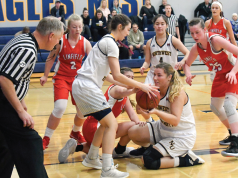Perhaps one of the more famous double whistles in recent memory happened in Game 1 of the 2018 NBA Finals. To set the scene: It’s the final 40 seconds of a two-point game between the Cleveland Cavaliers and Golden State Warriors. Kevin Durant drives to the basket and runs into LeBron James, who is attempting to take a charge.
Two whistles blow. The lead official steps out to give the offensive foul signal … only to notice the trail was about to signal a block. A quick look of acknowledgment and the lead makes the call.
The play led to an official review prompted to determine whether James was in the restricted area — a review that overturned the charging foul to a blocking foul. Let’s not concern ourselves with the review procedure; as high school or college basketball officials, we want to look more at how the two officials handled their double whistle, because we likely will have double (or even triple) whistles several times in our careers.
The most important thing to take away from this play was how the two officials gave each other a quick look before the lead, who would have the primary whistle on a secondary defender play, made the call.
“Acknowledgment is the key to every double whistle,” said Kevin Brill, a 26-year veteran NCAA Division I official on the West Coast. “You start with eye contact, verbal contact, and now you have a chance to discuss, verbally or nonverbally, who is going to take the play.”
Acknowledging a double whistle starts with taking a glance at whether your partner stopped the clock with an open hand (violation) or closed fist (foul). If you both have an open hand, the official with the primary coverage should signal the violation and resume play.
If one of you has an open hand and the other a closed fist, it becomes a matter of determining which came first. Did the violation happen before the foul (e.g., did a post player travel before getting fouled on a shot attempt)? Or did a foul cause the violation (e.g., was the post player pushed, causing the shuffle of the feet)?
Finally, if you both have closed fists, you also need to read body language. Did your partner take a step forward as if to punch a player-control foul? Or perhaps took a sideways step, ready to sell a blocking foul?
Either of these situations might require a quick check with your partner — emphasis on quick — to settle upon the right decision. Just a few words (“Push caused the travel” or “You got it, partner”) or a nod to the primary official should suffice.
In the NBA Finals play, the nonverbal communication between the lead and trail officials took only a second before the trail gave up the play.
“You really find out who the quality officials are when you work through double whistles with them,” Brill said. “The best officials acknowledge the whistle and communicate effectively and efficiently.”
While the NCAA men’s and NFHS officials’ manuals do not expressly spell out a procedure for how to handle double-whistle situations, the NCAA women’s manual devotes an entire section (3.4.7) to guidelines officials should follow to work through these plays.
Connie Perkins, a Pacific Northwest assigner who serves as the NCAA Division III representative on the CCA Mechanics Committee, said the committee wanted to promote consistency in double-whistle situations and make the process less contentious by adding the section to its manual.
Here are several key points from Section 3.4.7 of the CCA women’s manual that also apply to other levels of play:
- Officials must recognize when partners blow their whistle.
- Expect double whistles, especially in transition or where coverage areas intersect.
- Do not give an immediate preliminary signal on fouls.
- After a brief discussion, if both officials have the same call, release the play to the official from whose primary area the play originated.
“Ultimately, we want to get more plays correct, and we do that by having discipline within our coverage areas, both primary and secondary,” Perkins said. “Knowing primaries, slowing down after the whistle and not giving a preliminary signal make this process work.”
One thing this section of the CCA women’s manual does is eliminate the dreaded “blarge” double foul that happens when both officials give preliminary signals — one a charge, the other a block. Paragraph D of that section spells out that if both officials give differing preliminary signals, “the officials shall get together and agree to give the call to the official who had the best look at the play in order to get the call correct.”
Of course, we can avoid blarges by slowing down, recognizing situations and areas on the floor where double whistles can likely happen and not going immediately to sell a call, but “sticking and holding” a foul signal until it’s clear who will take the call.
A crew chief should emphasize all these principles during the pregame meeting. Both Brill and Perkins agreed a thorough discussion of how to handle double whistles in the pregame meeting is essential to deal successfully with them during the game.
Brill makes sure during his pregame to discuss how the right official should take the play to the table — and while the official in whose primary coverage area the foul occurs is often that official, that is not always the case.
“The right (official) is the crew member who should take the play to make the crew look as good as we can look as a team,” Brill said.
As he points out, the right official could have secondary coverage but has the first best look at the play. It could also be the outside official who Brill likens to the center fielder in baseball.
“The center fielder can see the whole play from a big-picture view as it develops, and sometimes the outside official has that same experience,” Brill said. “The key is who has the best look.”
Finally, on some plays with double whistles, Brill discusses with his crew pregame that being the right official means taking a play to the table to release some of the heat on a partner who has called the last couple of fouls.
No matter who ultimately takes the call to the table, determining that official should not take more than a second or two. Nothing can undermine the confidence of the players, coaches and spectators more than watching two officials have a long conversation.
Instead, build confidence by assuredly handling those inevitable double-whistle situations. We can’t all be NBA officials, but we can learn a lot from them.
René Ferrán is a freelance writer and editor who lives in Portland, Ore. He officiates high school basketball and baseball, as well as youth soccer.
What's Your Call? Leave a Comment:
Note: This article is archival in nature. Rules, interpretations, mechanics, philosophies and other information may or may not be correct for the current year.
This article is the copyright of ©Referee Enterprises, Inc., and may not be republished in whole or in part online, in print or in any capacity without expressed written permission from Referee. The article is made available for educational use by individuals.



















